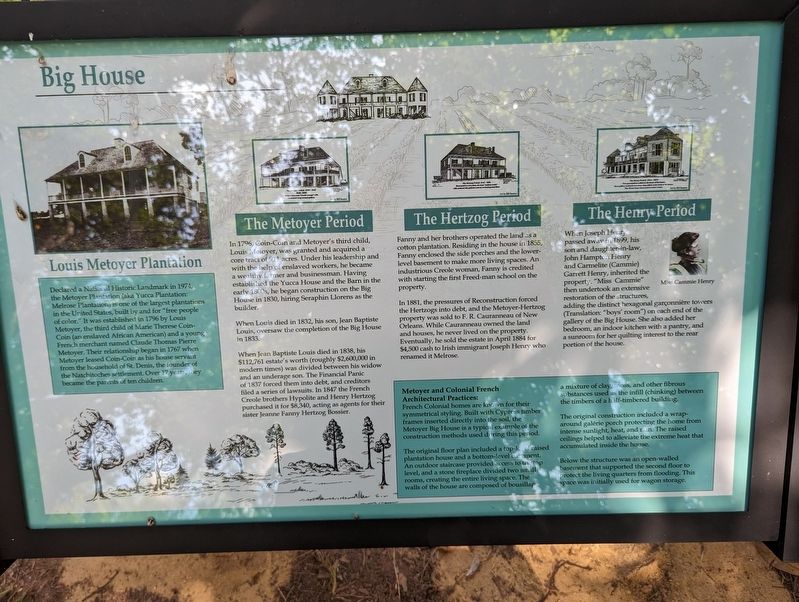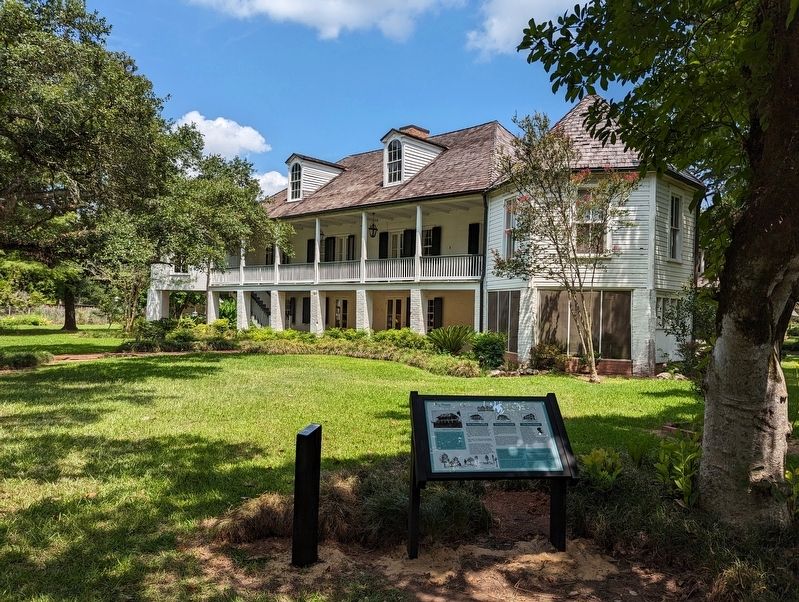Melrose in Natchitoches Parish, Louisiana — The American South (West South Central)
Big House
Declared a National Historic Landmark in 1974, the Metoyer Plantation (aka Yucca Plantation: Melrose Plantation) is one of the largest plantations in the United States, built by and for "free people of color." It was established in 1796 by Louis Metoyer, the third child of Marie Therese Coin- Coin (an enslaved African American) and a young French merchant named Claude Thomas Pierre Metoyer. Their relationship began in 1767 when Metoyer leased Coin-Coin as his house servant from the household of St. Denis, the founder of the Natchitoches settlement. Over 17 years, they became the parents of ten children.
In 1796, Coin-Coin and Metoyer's third child, Louis Metoyer, was granted and acquired a core tract of 911 acres. Under his leadership and with the help of enslaved workers, he became a wealthy farmer and businessman. Having established the Yucca House and the Barn in the early 1800s, he began construction on the Big House in 1830, hiring Seraphin Llorens as the builder.
When Louis died in 1832, his son, Jean Baptiste Louis, oversaw the completion of the Big House in 1833.
When Jean Baptiste Louis died in 1838, his $112,761 estate's worth (roughly $2,600,000 in modern times) was divided between his widow and an underage son. The Financial Panic of 1837 forced them into debt, and creditors filed a series of lawsuits. In 1847 the French Creole brothers Hypolite and Henry Hertzog purchased it for $8,340, acting as agents for their sister Jeanne Fanny Hertzog Bossier.
Fanny and her brothers operated the land as a cotton plantation. Residing in the house in 1855, Fanny enclosed the side porches and the lower- level basement to make more living spaces. An industrious Creole woman, Fanny is credited with starting the first Freed-man school on the property.
In 1881, the pressures of Reconstruction forced the Hertzogs into debt, and the Metoyer-Hertzog property was sold to F. R. Cauranneau of New Orleans. While Cauranneau owned the land and houses, he never lived on the property. Eventually, he sold the estate in April 1884 for $4,500 cash to Irish immigrant Joseph Henry who renamed it Melrose.
When Joseph Henry passed away in 1899, his son and daughter-in-law, John Hampton Henry and Carmelite (Cammie) Garrett Henry, inherited the property. "Miss Cammie" then undertook an extensive restoration of the structures, Miss Cammie Henry adding the distinct hexagonal garçonnière towers (Translation: "boys' room") on each end of the gallery of the Big House. She also added her bedroom, an indoor kitchen with a pantry, and a sunroom for her quilting interest to the rear portion of the house.
French Colonial homes are known for their symmetrical styling. Built with Cypress timber frames inserted directly into the soil, the Metoyer Big House is a typical example of the construction methods used during this period.
The original floor plan included a top-level raised plantation house and a bottom-level basement. An outdoor staircase provided access to the top level, and a stone fireplace divided two small rooms, creating the entire living space. The walls of the house are composed of bousillage, a mixture of clay, moss, and other fibrous substances used as the infill (chinking) between the timbers of a half-timbered building.
The original construction included a wrap- around galérie porch protecting the home from intense sunlight, heat, and rain. The raised ceilings helped to alleviate the extreme heat that accumulated inside the house.
Below the structure was an open-walled basement that supported the second floor to protect the living quarters from flooding. This space was initially used for wagon storage.
Topics. This historical marker is listed in these topic lists: Architecture • Notable Buildings.
Location. 31° 35.984′ N, 92° 57.993′ W. Marker is in Melrose, Louisiana, in Natchitoches Parish. Marker can be reached from Route 119, half a mile south of Route 493, on the left when traveling south. Touch for map. Marker is at or near this postal address: 3533 LA-119, Melrose LA 71452, United States of America. Touch for directions.
Other nearby markers. At least 8 other markers are within walking distance of this marker. The Bindry (a few steps from this marker); Weaving House (a few steps from this marker); Yucca Plantation (a few steps from this marker); African House and Clementine Hunter's Murals (within shouting distance of this marker); Clemetine Hunter Home and Studio (within shouting distance of this marker); Melrose Barn (within shouting distance of this marker); Yucca House (about 300 feet away, measured in a direct line); Ghana House (about 300 feet away). Touch for a list and map of all markers in Melrose.
More about this marker. Located on the grounds of the Melrose Plantation. Admission required for either a self walking grounds tour, or guided tour of entire complex.
Credits. This page was last revised on July 23, 2023. It was originally submitted on July 23, 2023, by Cajun Scrambler of Assumption, Louisiana. This page has been viewed 77 times since then and 23 times this year. Photos: 1, 2. submitted on July 23, 2023, by Cajun Scrambler of Assumption, Louisiana.

